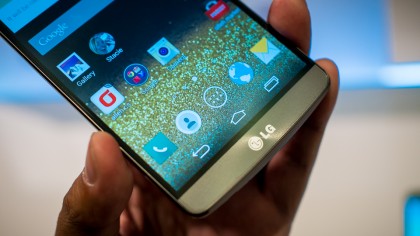QHD: why it's the future of smartphones
QHD? Surely that's not needed

2014 is shaping up to be the year of QHD displays on our smartphones. The Oppo Find 7 and Vivo Xplay 3S signalled the start, and now the Chinese manufacturers have been joined by the Korean mobile giant of LG and the LG G3.
Quad HD (QHD) comes with four times more pixels than a 720p HD display and it's the next step up from full HD (1920 x 1080) with a 2560 x 1440 resolution.
Of course 4K still resides above QHD, but that tech is only just making its way onto high-end TVs and computer monitors so we're unlikely to see it hit our smartphones this year.
While the likes of the Samsung Galaxy S5 and HTC One M8 launched with full HD screens there are rumors pointing towards QHD reboots of both in the form of the Galaxy S5 Prime and One M8 Prime.
- Read our hands on: LG G3 review
Looking back mobile displays have dramatically increased both in size and resolution whilst managing to keep battery life fairly impressive; just take a look at HTC's One M8.
Screens have grown from the 3.7-inch, 480 x 800 (252 ppi) Google Nexus One of 2010 to the full HD displays of the 5.1-inch (432ppi) Galaxy S5 and 5.2-inch (424ppi) Sony Xperia Z2 in 2014.
The difference that four years has made is nothing short of astounding.
Sign up for breaking news, reviews, opinion, top tech deals, and more.
It was only a matter of time before manufacturers looked for the next step in screen technology, so the arrival of the 538ppi, 5.5-inch QHD LG G3 and reports of potential M8 Prime and S5 Prime handsets are hardly a surprise.
Why oh why?
Why are mobile manufacturers so interested in QHD displays at the moment? According to Michelle Leyden Li, Qualcomm's Senior Director of Marketing, the answer is simply 'us'.
"Consumers never seem to be satisfied and people want more and more things on their devices," Li explains.
"People are using their phones more for movies, TV, video... it's their own personal device and they want a beautiful experience."
It is that experience that is driving consumers to the high end flagship devices, with Apple's Retina display causing excitement when it was released on the iPhone 4.
There's always an appetite for ever brighter and more high resolution displays, as it leads to consumers feeling like they're getting a next generation of technology for their money.

As consumers we might be the ones pushing for increased resolutions, but is it really in our best interests? According the Huawei boss Richard Yu the answer is a very clear no.
"I don't think we need QHD displays on mobiles. Your eyes totally cannot identify between full HD and 2K on a smartphone. You can't distinguish the difference, so it's totally nonsense," Yu told us at the launch of the firm's Ascend P7 flagship.
"We can [put a QHD display on a smartphone], but it's very bad for power consumption and it doesn't offer anything in return."
LG doesn't agree with Mr Yu - shock horror - with the QHD display providing the same resolution we're accustomed to in high resolution printed magazines and art books.
"We don't want to compete with someone else in the digital world [when it comes to displays]. LG is known for creating beautiful displays for years, and with the QHD screen we're trying to end that battle," explained Dr Ramchan Woo, head of smartphone development at LG.

The need for QHD on the G3 came from LG's research in the print industry, where it found that high res art books have pages equating to around 540ppi.
That pixel density can be matched by QHD displays, and LG claims it also offers improved colour reproduction and sharpness when viewing text.
- 1
- 2
Current page: Why are QHD displays on our smartphones?
Next Page Battery pressures and a 4K future